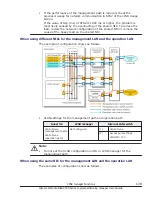
VLAN mode of
sending ports
Sending Frame
Untagged
Tagged
(=VLAN ID)
1
Tagged
(≠VLAN ID)
1
Tagged
Sent
Sent
-
2
Untagged
-
2
Sent
(Deleting Tags)
-
2
Notes:
1
.
Untagged frames are received at the untagged ports. Frames that have got
tagged are included.
2
.
Not selected as the addressed port for frames.
By combining the above Logical NIC settings and guest OS VLAN settings,
you can divide broadcast domains as follows.
•
Divide a virtual network into multiple broadcast domains for each Logical
NIC
On the Virtual NIC (VNIC) Assignment screen, specify "untagged port" for
the Logical NIC and the VLAN ID to which it belongs. There is no need to
make VLAN settings in the guest OS because there will be no tags on the
packets received by the Logical NIC. This means that the guest OS will
not be aware of the VLAN, so you can divide the broadcast domain for
each Logical NIC.
•
Assign one Logical NIC to multiple broadcast domains within the same
virtual network
By making VLAN settings for the Logical NIC from the guest OS, you can
use the functions equivalent to the physical NIC to operate tags and
perform frame filtering. In addition, on the Virtual NIC (VNIC) Assignment
screen, specify "tagged port" for the Logical NIC and specify all the VLAN
IDs specified for the Logical NIC in the guest OS.
This will make it possible to handle more than one VLAN ID per Logical
NIC and assign the Logical NIC to more than one broadcast domain.
Example of TagVLAN Function
The following is an example of using VLAN functions.
1-48
LPAR manager Functions
Hitachi Compute Blade 500 Series Logical partitioning manager User's Guide
















































